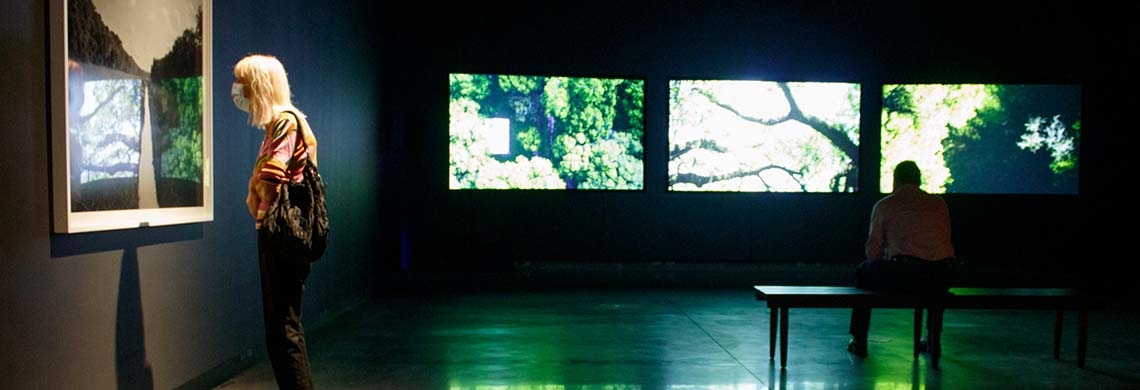Someone’s praying
someone’s praying
someone’s pain
someone’s brain
someone’s praying
The whispers multiply and fade in and out, snaking like fragments of a dream. A rattle shakes. Sugarcane leaves sway in the breeze. A cry pierces the incantation—high, sharp, cracking as it grows more pained. Keening, the soprano voice soars above the plantation grounds, as high as the old live oaks overhead. The camera slowly pans underneath, looking up into the fractal forms against the sky. Silent vestiges of the past, the oaks stand witness.
We saw it all, they seem to say. We saw everything.

The enveloping video triptych Evergreen greets visitors to the Scovery Gallery. (Photograph by Seth Boonchai, courtesy of Dawoud Bey and Sean Kelly Gallery, New York)
This ghostly meditation is Evergreen, a triptych video installation by the photographer Dawoud Bey in collaboration with vocalist and composer Imani Uzuri. The enveloping work is on view at The Historic New Orleans Collection as part of the citywide art exhibition Prospect.5: Yesterday We Said Tomorrow. Bey, a native of Queens, New York, and a current Chicagoan, is a longtime star of the art world, known for his reverent depictions of Black life in America. Evergreen and In This Here Place, a photographic complement to the video installation, are his first major projects inspired by and shown in New Orleans, and he has trained his lens on four former plantations in the river parishes.
Evergreen, full of saturated color and named for the plantation where it was filmed, is projected at one end of the Tricentennial Wing’s Scovern Gallery, while the rest of the space is occupied by the large-format black-and-white photographs that make up In This Here Place.
“For me, first of all, the work is a kind of deep witnessing,” Bey said, speaking at the October 23 opening of Prospect.5, the fifth iteration of Prospect New Orleans. “It’s about being in these places, and being there and wanting to visualize them in a way that makes them engaging.”
That engagement, Bey said, is deeply tied to the history of those sites—what they represent to not only Black America but all America. “We’re talking about the foundation of the economic structure of this country,” he said.

A dwelling formerly inhabited by enslaved people stands behind a live oak tree in Tree and Cabin, one of Dawoud Bey’s large-format black-and-white photographs on display as part of In This Here Place. (Image courtesy of the artist and Sean Kelly Gallery, New York)
Bey opted not to depict the “big house” at any of the sites, nor did he capture people in the images. Rather, he provides long, lingering glances at the natural surroundings and dwellings formerly inhabited by enslaved people, always from a respectful remove but close enough to see the grain of the wood steps and the detailed shadows across their cladding.
He dwelled on Evergreen in particular because it is the only plantation in the Deep South that features multiple original, extant slave cabins—22 of them, spread out over the grounds. “Evergreen is the most undisturbed plantation landscape in the country,” Bey said. “The other plantations I photographed … they’re constructed largely in concern for a visitor experience that can be completed in a half hour. Evergreen, on the other hand, remains exactly as it has been since it was built.
“There’s a presence that you feel when you’re at Evergreen that is undeniable. There is a spirit that clings to that site more heavily than any of the other sites.”

In Irrigation Ditch, Bey summons tension between movement and stasis, freedom and constraint. (Image courtesy of the artist and Sean Kelly Gallery, New York)
Bey’s photographs also take the viewer through sugarcane fields and swamps, filling the entire frame with a historically informed sense of place. Scale—the large-format photographs, each one several feet in width and height, set against black walls and low lighting—was an important consideration. “If you stand very close to them, it kind of shuts out the rest of the world,” Bey said. “It becomes more experience-driven than just about that object of the photograph. … Scale, for me, is about creating a very particular and intentional kind of relationship between the viewer and the narrative that’s enveloped in the vision.”
The narratives of the plantation past are “very complex,” and they cannot be defined solely by the anguish and horror of slavery, Bey said. “Resistance is also a part of the landscape of the plantation, along with the history of the vibrant musical culture that comes out of the plantation—those songs and inspiration, aspiration and resistance.”
Uzuri, in her score for Evergreen, incorporates an array of elements of Black musical culture: gourd shakers, handclaps and leg pats, spirituals, opera, and prayer.
“My intention is to provoke a conversation about that history that leads to conversation about the complexities of those narratives and how those narratives are very much a part of the contemporary moment,” Bey said.
“Or, as I like to say, history explains everything. There are no mysteries. History explains everything.”
This article appears in the winter 2022 issue of THNOC Quarterly.












